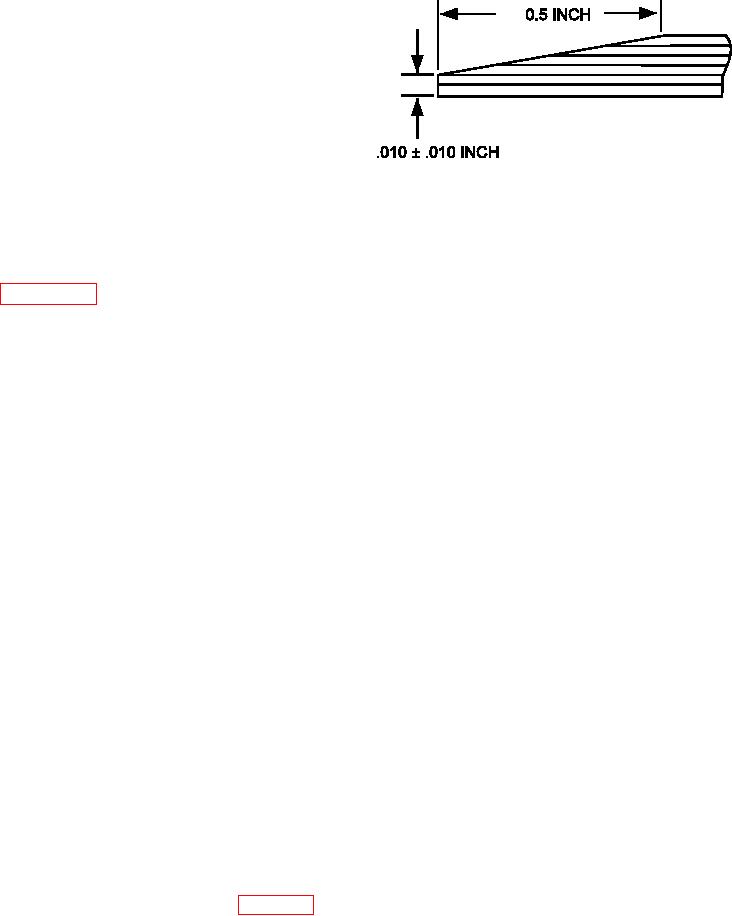
TM 1-1500-204-23-11
will be required. The heat entrapment tent may be
fabricated from nylon vacuum bag material taped to the
part surface outside the repair area and insulated as
required with polyester or iberglass breather material.
6-7. SURFACE PREPARATION FOR BONDING. T-
he simplicity and high degree of bond durability of this
process has contributed signiicantly to the repairability
of advanced composite parts. Unlike metallic parts,
the surface preparation does not require an elaborate
and process sensitive procedure using chemicals that
Figure 6-10. Patch Edge Taper Dimensions
are dificult to work with and dispose of to obtain a
successful bond.
(3) Sand (by hand or with an orbital sander)
both surfaces of the patch with an abrasive
a. Surface Preparation For Resin Matrix. Surface
paper according to the system speciic tech-
preparation for resin matrix composites consists of
nical manual. If no sandpaper is speciied,
sanding with ine grit abrasive paper. Clean according
use 150-180 grit. Ensure that the majority of
to paragraph 6-5 until no further evidence of sanding
any peel ply impressions on the patch sur-
residue appears on the cloth.
face are removed as these impressions can
act as recesses that will trap air and other
(1) Use wiping cloth for wiping. This will reduce
vapors. Sand carefully to minimize removal
the potential for contamination of surfaces to
of load carrying ibers. Ensure 100% cover-
be bonded.
age of the patch surfaces during sanding.
NOTE
(4) The patch still requires sanding even if peel
If the patch is precured and contains peel
ply was not used during patch manufacture
ply material, the peel ply should be left on
(peel ply impression will not be present on
the patch until the surface preparation step
patch surface). This will remove any poten-
to prevent contamination.
tial contamination from the patch manufac-
turing process and will roughen the surface
ensuring.
(2) Cover surfaces prepared for bonding with
clean barrier material taped in place to pre-
(5) Wipe the sanded surfaces with a clean, dry
vent contamination while preparing for layup.
cloth to remove sanding residue. Inspect
the cloth for evidence of sanding residue.
b. Surface Preparation For Pre-cured Composite
Repeat wiping process until no further evi-
Patches. Perform the following steps to prepare a sur-
dence of sanding residue exists on the cloth.
face for bonding using pre-cured composite patches.
For each repeat wipe use a new, clean, dry
cloth.
(1) Cautiously remove the peel ply from both
surfaces of the patch to prevent pulling ibers
(6) From this point forward, handle the patch
out of the patch material. If iber removal
wearing powder free latex gloves. Cover the
starts during peel ply removal, change the
patch with clean barrier material until ready
peel ply removal direction so that peel ply
for layup.
is being removed 90 to the patch outer ply
ibers.
c. Surface Preparation for a Part Surface. Per-
form the following steps to prepare the part surface
(2) If the patch is cut from pre-cured square
for bonding.
sheet stock, the edge of the patch must
be tapered. Tapering is required to reduce
(1) Sand the part surface in the area where the
adhesive peel stresses at the edge of the
patch is to be applied with an abrasive paper
patch. First, cut the patch from pre-cured
according to the system speciic technical
square sheet stock to the dimensions
manual. If no sandpaper is speciied, use
required for the repair patch. Then, taper
150-180 grit. Ensure the majority of any
the patch edge as shown in igure 6-10. Use
peel ply impressions on the part surface
a 90 degree router motor and an 80-100 grit
are removed. Sand carefully to minimize
abrasive disk.
removal of load carrying ibers. Ensure
100% coverage of the patch bond area.

